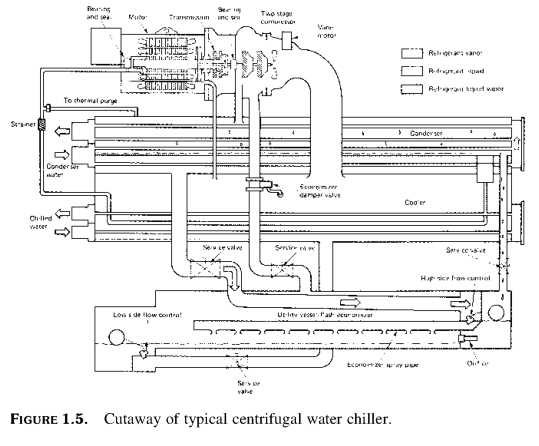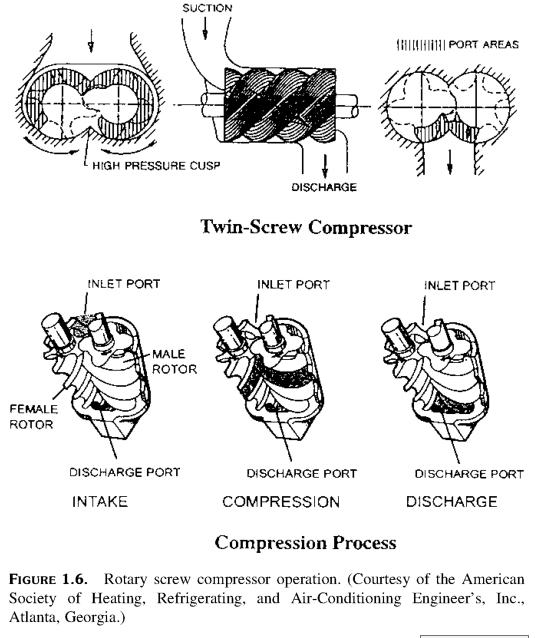Rotary Compressors
For large capacity (from 100 tonnes and above 10,000 tonnes), rotary compressor water chillers are used. There are two types of rotary compressors used: volumetric rotary screw compressors and centrifugal compressors.
On Fig. 1.6 shows rotary screw compressor screw operations. Screw compressors use double-knit spiral fluted rotors with man blades and woman flute or ravines in stationary building. Compression obtained by direct reduction of volume of pure rotary motion. As the rotors start unmesh, a void is created on both the male and female sides, that allows the refrigerant gas movement in the compressor. Further rotation is merging with another male with the female share flute, reduce footprint, and compress gas trapped. At a point determined by the design of the ratio of the volume, port of unloading is uncovered and the gas is released in the condenser.
Power regulator screw compressors is typically achieved by opening and closing the slide compressor suction valve to regulate the flow of refrigerant in the compressor.
Speed control can also be used to control capacity.
Design of centrifugal compressors for refrigeration debt arose Dr. Willis carrier immediately after the first World War centrifugal compressor, pressure increases gas by increasing its kinetic energy. Kinetic energy is converted into static pressure, when REFRIGERANT gas leaves the compressor and is expanding in the condenser. On Fig. 1.5 shows a typical centrifugal chiller water configuration. Compressor and engine are sealed in one case and the gaseous refrigerant is used for cooling the motor windings are in the process of exploitation. Low pressure gas streams from the refrigerator compressor. Gas flow rate is controlled by a set of preswirl inlet vanes, which regulate the rate of flow of a gas-refrigerant in the compressor in response to the cooling load on the cooler.
As a rule, at the outlet of the unit fully variable in the range 15100% of full capacity. High pressure gas enters the condenser, where the water absorbs heat and gas phase change in liquid. Liquid, in turn, flows into the cooler, where it evaporates, cooling the cooling water.
Centrifugal compressor chillers using R-134A or R-22 is defined as a positive pressure machines, while those using R-123 are negative-pressure machines based on the evaporator pressure condition. In ARI standard rating conditions, and R-134A refrigerant pressure in the evaporator 36,6 psig and condenser pressure 118.3 psig, giving a total increase of pressure or lift compressor 81,7 pounds per square inch. However, for R-123, these pressure conditions 5.81 psig in the evaporator and 6.10psig in the condenser, yielding a total rise of 11.91 pounds per square inch.

Mass flow for both refrigerants are essentially the same about 3 kg/min ton. However, due to the much higher density of R-134A, its volumetric flow rate (cfm/t), which determines the size of the impeller, more than five times less than that of R-123 volumetric flow.
Compressors with R-123 tend to use large-diameter wheels (about 40 century diameter) and direct dialing, that engines (at 60 Hz) turn at 3600 rpm Compressors with R-134A, as a rule, use much less, impellers (about 5 century diameter), which in a combination of electric motor through a reduction gear or speed accelerator and can operate at speeds approaching 30 000 R / min
Large diameter wheels necessary R-123 puts design constraint on the compressor and reduce the diameter, they typically use two or three wheels in series or stages to produce the equivalent of pressure increase.

In practice, the way out-flow from one stage to the next, enter the pressure loss, which reduces the efficiency to some extent. Since the evaporator positive-pressure chillers is maintained at a pressure greater than atmospheric, any leakage in the cooling system will lead to the loss of refrigerant and the effect of any leaks quickly evidence of the low level of refrigerant in the chiller. However, any leaks associated with negative pressure, machine as a result of atmospheric air (consisting of non-condensable gases and water vapor) in the chiller.
Non-condensable gases create two problems:
- The compressor operates at compression of non-condensable gases, but they do not offer a cooling effect.
- Non-condensable gases can blanket evaporator and condenser tubes, reducing the efficiency of the heat exchanger.
Non-condensable gases may reduce the chiller efficiency by as much as 14% at full load. Moisture is introduced with the atmospheric air pollutants that may allow the formation of acids in the cooler, which can cause serious damage to the motor windings (hermetic motors and bearings.
To eliminate potential of non-condensable gases and moisture negative-pressure chillers, these chillers are equipped with clean units. While clean the units are very effective at separating and ventilation of non-condensable gases and moisture from the refrigerant, they are not 100%effective, and some refrigerant emitted into the atmosphere each time to clean the device works. In addition, to reduce the risk of leakage when chillers, on the evaporator should be provided with external heater supply to lift the pressure in the refrigerant circuit is higher than the atmospheric one.
Energy demand for the chiller compressor at peak load is a function of (1) are required leaving chilled water temperature, and (2) the temperature of the accessible water capacitor. As leaving chilled water temperature decreases, the energy demand for the compressor increases, as shown in Table 1.4. Exactly the same as the condenser water temperature increases, the compressor requires more energy (see Chap. 10). Thus, the designer can minimize cooling energy input with the use of rotary compressor chiller selected to run with the maximum leaving chilled water temperature and the minimum temperature of the condenser water...
|


